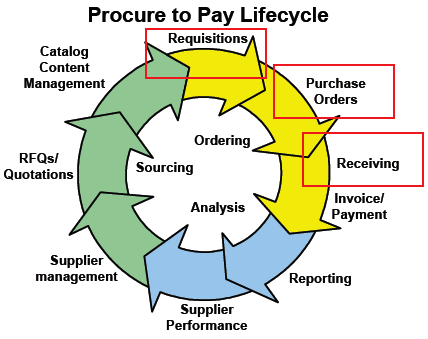Purchasing Cycle

Successful purchasing organizations follow a purchasing cycle or process to ensure that the important elements are not overlooked. Each material or service being procured will require a different level of activity and priority. The experienced purchaser will ensure that each of the ten steps is fully performed and executed.
The purchasing cycle consists of the following steps:
Receiving and analyzing purchase requisitions.
Selecting suppliers. Finding potential suppliers, issuing requests for quotations, receiving and analyzing quotations, and selecting the right supplier.
Determining the right price.
Issuing purchase orders.
Following up to assure delivery dates are met.
Receiving and accepting goods.
Approving supplier’s invoice for payment.
1. Receiving and analyzing purchase requisition
Purchase requisitions start with the department or person who will be the ultimate user. In the material requirements planning environment, the planner releases a planned order authorizing the purchasing department to go ahead and process a purchase order. At a minimum, the purchase requisition contains the following information:
Identity of originator, signed approval, and account to which cost is assigned.
Material specification.
Quantity and unit of measure.
Required delivery date and place.
Any other supplemental information needed
2. Selecting suppliers
Identifying and selecting suppliers are important responsibilities of the purchasing department. For routine items or those that have not been purchased before, a list of approved suppliers is kept. If the item has not been purchased before or there is no acceptable supplier on file, a search must be made. If the order is of small value or for standard items, a supplier can probably be found in a catalogue, trade journal, or directory.
2.1 Requesting quotations
For major items, it is usually desirable to issue a request for quotation. This is a written inquiry that is sent to enough suppliers to be sure competitive and reliable quotations are received. It is not a sales order After the suppliers have completed and returned the quotations to the buyer, the quotations are analyzed for price, compliance to specification, terms and conditions of sale, delivery, and payment terms. For items where specifications can be accurately written, the choice is probably made on price, delivery, and terms of sale. For items where specifications cannot be accurately written, the items quoted will vary. The quotations must be evaluated for technical suitability. The final choice is a compromise between technical factors and price. Usually both the issuing and purchasing departments are involved in the decision.
3. Determining the right price
This is the responsibility of the purchasing department and is closely tied to the selection of suppliers. The purchasing department is also responsible for price negotiation and will try to obtain the best price from the supplier.
4. Issuing a purchase order
A purchase order is a legal offer to purchase. Once accepted by the supplier, it becomes a legal contract for delivery of the goods according to the terms and conditions specified in the purchase agreement. The purchase order is prepared from the purchase requisition or the quotations and from any other additional information needed. A copy is sent to the supplier; copies are retained by purchasing and are also sent to other departments such as accounting, the originating department, and receiving.
5. Following up and delivery
The supplier is responsible for delivering the items ordered on time. The purchasing department is responsible for ensuring that suppliers do deliver on time. If there is doubt that delivery dates can be met, purchasing must find out in time to take corrective action. This might involve expediting transportation, alternate sources of supply, working with the supplier to solve its problems, or rescheduling production.
The purchasing department is also responsible for working with the supplier on any changes in delivery requirements. Demand for items changes with time, and it may he necessary to expedite certain items or push delivery back on some others. The buyer must keep the supplier informed of the true requirements so that the supplier is able to provide what is wanted and when.
6. Receiving and accepting goods
When the goods are received, the receiving department inspects the goods to be sure the correct ones have been sent, are in the right quantity, and have not been damaged in transit. Using their copy of the purchase order and the bill of lading supplied by the carrier, the receiving department then accepts the goods and writes up a receiving report noting any variance. If further inspection is required, such as by quality control, the goods are sent to quality control or held there for inspection. If the goods are received damaged. the receiving department will advise the purchasing department and hold the goods for further action. Provided the goods are in order and require no further inspection, they will be sent to the originating department or to inventory.
A copy of the receiving report is then sent to the purchasing department noting any variance or discrepancy from the purchase order. If the order is considered complete, the receiving department closes out its copy of the purchase order and advises the purchasing department. If it is not, the purchase order is held open awaiting completion. If the goods have also been inspected by the quality control department, they, too, will advise the purchasing department whether the goods have been accepted or not.
7. Approving supplier’s invoice for payment
When the supplier’s invoice is received, there are three pieces of information that should agree: the purchase order, the receiving report, and the invoice. The items and the quantities should be the same on all; the prices, and extensions to prices, should be the same on the purchase order and the invoice. All discounts and terms of the original purchase order must be checked against the invoice. It is the job of the purchasing department to verify these and to resolve any differences. Once approved, the invoice is sent to accounts payable for payment.